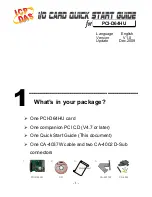
ENGINEERING MANUAL OF AUTOMATIC CONTROL
AIR HANDLING SYSTEM CONTROL APPLICATIONS
259
19
SA temperature setpoint is reset based upon
OA temperature.
20-22
Mixing dampers modulate for free cooling.
23,24
Mixing box static pressure maintained constant
during noneconomizer mode by modulation of
the RA damper during minimum ventilation
periods to maintain constant OA airflow.
25-27
Hot water valve, mixing dampers, and chilled
water valve modulated in sequence to
maintain SA temperature setpoint.
28,29
SA temperature setpoint switches from cooling
to heating value during warm-up modes.
30
RA temperature determines end of warm-up
mode.
32
Control program coordinates return fan
airflow setpoint, loading, exhaust fan control,
and fan interlock.
33
Control program coordinates temperature
control of mixing dampers, control valves,
and fan interlock.
FEATURES
1. The system admits outdoor air for cooling based upon
the economizer program decision.
2. Supplies constant temperature variable volume (energy
conserving) air to VAV boxes during cooling mode.
3. Provides constant airflow of OA in summer with varying
supply airflow.
4. Return fan airflow varies with supply fan airflow
dependent upon exhaust and pressurization requirements.
5. Provides 100% RA during warm-up periods.
6. Perimeter boxes provide heat when required.
7. SA temperature setpoint is reset based upon OA
temperature.
NOTE: This function has no hardware cost. The setpoint
parameters are easily adjusted and can be nulled by
setting the -21
°
C OA SA setpoint the same as the 4
°
C
OA SA setpoint.
CONDITIONS FOR SUCCESSFUL OPERATION
1. Skilled HVAC technicians required for pressure and
volumetric setup.
2. Test and balance OA damper minimum position value
and mixing box static pressure setpoint value..
3. OA and RA dampers maintained and provided with
proper actuators (with positioners if pneumatic).
4. Airflow elements and transducers kept clean and calibrated.
SPECIFICATIONS
See FAN SYSTEM START-STOP CONTROL.
Anytime the supply fan runs, the return fan shall start and
the control system shall be enabled. Also, anytime the supply
fan runs during scheduled occupancy periods, mixing dampers
shall position to minimum ventilation position and the exhaust
fan shall start.
Anytime the economizer mode is enabled, the temperature
controls shall be enabled to override the AHU mixing dampers
minimum ventilation setpoint for free cooling as required.
During noneconomizer occupied periods the RA damper shall
be modulated to maintain a constant mixing box negative static
pressure.
The supply fan loading shall be under EPID control with a
start value of 20% and ramp duration of 150 seconds. The supply
fan shall load to provide design static pressure at the end of the
longest duct.
The return fan loading shall be dependent upon the supply
fan airflow. When in the recirculating mode, the return fan
airflow setpoint shall equal the supply fan airflow plus a
positive or negative value for calibration (of flow elements
and transducers) so as to provide a neutral space static
pressure. Anytime the OA dampers are not closed
completely, the return fan airflow setpoint shall equal the
supply fan airflow minus a value necessary to maintain a
slightly positive (0.01 Pa) space static pressure. Anytime
the exhaust fan operates, the return fan airflow setpoint shall
be further reduced by additional airflow value equal to the
exhaust airflow (this exhaust value shall be determined by
observing the space static pressure as the exhaust fan starts
and stops).
The SA temperature shall be under EPID control with a start
value of 33 (at which point the hot and chilled water valves are
closed and the mixing damper override signal is zero) and a
ramp duration of 120 seconds. The hot and chilled water valves
and the mixing dampers shall be modulated in sequence to
maintain the SA temperature setpoint.
Anytime the optimum start perimeter zone space temperature
sensor is less than 21
°
C at startup time, the SA temperature
setpoint shall be 32
°
C until the RA temperature rises to 23.5
°
C,
at which time the SA temperature setpoint shall be lowered to
the cooling SA setpoint. The SA EPID shall be invoked at the
switching of the setpoint to cooling with a start value of 33 and
a ramp duration of 180 seconds. The cooling SA setpoint shall
rise from 13
°
C to 16
°
C as the OA temperature drops from 4
°
C
to –21
°
C.
Summary of Contents for AUTOMATIC CONTROL SI Edition
Page 1: ...AUTOMATIC CONTROL for ENGINEERING MANUAL of COMMERCIAL BUILDINGS SI Edition ...
Page 4: ...ENGINEERING MANUAL OF AUTOMATIC CONTROL iv ...
Page 6: ...ENGINEERING MANUAL OF AUTOMATIC CONTROL vi ...
Page 46: ...ENGINEERING MANUAL OF AUTOMATIC CONTROL CONTROL FUNDAMENTALS 36 ...
Page 66: ...ENGINEERING MANUAL OF AUTOMATIC CONTROL PSYCHROMETRIC CHART FUNDAMENTALS 56 ...
Page 128: ...ENGINEERING MANUAL OF AUTOMATIC CONTROL ELECTRIC CONTROL FUNDAMENTALS 118 ...
Page 158: ...MICROPROCESSOR BASED DDC FUNDAMENTALS 148 ENGINEERING MANUAL OF AUTOMATIC CONTROL ...
Page 208: ...ENGINEERING MANUAL OF AUTOMATIC CONTROL BUILDING MANAGEMENT SYSTEM FUNDAMENTALS 198 ...
Page 493: ...INDEX ENGINEERING MANUAL OF AUTOMATIC CONTROL 483 INDEX ...
Page 506: ...ENGINEERING MANUAL OF AUTOMATIC CONTROL INDEX 496 NOTES ...
Page 507: ...INDEX ENGINEERING MANUAL OF AUTOMATIC CONTROL 497 NOTES ...
Page 508: ...ENGINEERING MANUAL OF AUTOMATIC CONTROL INDEX 498 NOTES ...
Page 509: ...INDEX ENGINEERING MANUAL OF AUTOMATIC CONTROL 499 NOTES ...
Page 510: ...ENGINEERING MANUAL OF AUTOMATIC CONTROL INDEX 500 NOTES ...
Page 511: ...INDEX ENGINEERING MANUAL OF AUTOMATIC CONTROL 501 NOTES ...
Page 512: ...ENGINEERING MANUAL OF AUTOMATIC CONTROL INDEX 502 NOTES ...
















































